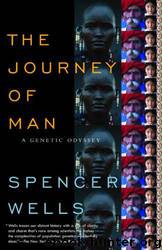The Journey of Man: A Genetic Odyssey by Spencer Wells

Author:Spencer Wells [Wells, Spencer]
Language: eng
Format: epub, azw3
Tags: Non-Fiction
ISBN: 9780307830456
Amazon: B009MYAOQU
Publisher: Random House Trade Paperbacks
Published: 2002-10-30T08:00:00+00:00
6
The Main Line
Now here, you see, it takes all the running you can do, to keep in the same place. If you want to get somewhere else, you must run at least twice as fast as that!
Lewis Carroll, Through the Looking Glass
As I mentioned at the beginning of the last chapter, my lineage of Y-chromosome markers coalesces back to a DNA polymorphism known as M168, the ancestor of everyone living outside of Africa. M168 unites me with the Australian coastal migrants, tracing us both back to Africa around 50,000 years ago. This places all non-Africans in that continent immediately after the earliest archaeological evidence for the Great Leap Forward, and suggests a causal relationship between this ancient cultural revolution and the migration of modern humans out of Africa. The people who stayed in Africa, as well as the ones who left, would have been fully modern in every respect – technologically, culturally and artistically. The mitochondrial DNA results suggest that a massive expansion in human populations began around this time, consistent with the range expansion we see in the archaeological record. The Y and mtDNA data hint at two routes, one of which would have followed the coast to Australia around 50–60,000 years ago. What about the other, which accounts for the majority of people in the world today?
Before we begin to trace the order of the additional markers on my lineage, and their significance to our story, we need to clarify what the order actually signifies. There are two issues to be considered here, and both involve timing. The first is what we might call relative dating. To understand this, it is worth revisiting our hypothetical kitchen. Like the maternal and paternal soup recipes, the genetic recipes we have all inherited contain a combination of ingredients, or markers, that distinguish them from everyone else’s soup. In order to establish the order in which the ingredients were modified, we need to compare many different recipes before we begin to see patterns. So let’s do a bit of genetic cooking.
Imagine having an international potluck supper, where everyone invited is asked to bring a soup that is specific to his or her own country. In our kitchen we have several dozen bowls of soup sitting on the table. Each has a slightly different recipe, but they all come from the same source. How do we know this? Because each recipe uses as its basic ingredient impala – a species of antelope that occurs naturally only in Africa. It is extremely difficult to obtain impala meat in many parts of the world, but it is the cornerstone of all the soup recipes and it must be included.
As we taste the soups, we begin to detect another pattern. Some contain black pepper, while others contain salt. These are the two main soup categories, and if you have one you don’t have the other. There are many additional variants among the salt recipes – some with fish, others with barley, a few with unusual spices you can’t identify – but they are all united by the presence of salt.
Download
The Journey of Man: A Genetic Odyssey by Spencer Wells.azw3
This site does not store any files on its server. We only index and link to content provided by other sites. Please contact the content providers to delete copyright contents if any and email us, we'll remove relevant links or contents immediately.
| Fossils | Game Theory |
| Genetics | Molecular Biology |
| Organic | Paleontology |
Sapiens: A Brief History of Humankind by Yuval Noah Harari(13040)
Sapiens by Yuval Noah Harari(4531)
Homo Deus: A Brief History of Tomorrow by Yuval Noah Harari(4273)
Pale Blue Dot by Carl Sagan(3996)
Origin Story: A Big History of Everything by David Christian(3133)
Livewired by David Eagleman(3116)
Brief Answers to the Big Questions by Stephen Hawking(2873)
Inferior by Angela Saini(2829)
Origin Story by David Christian(2677)
The Evolution of Beauty by Richard O. Prum(2551)
Signature in the Cell: DNA and the Evidence for Intelligent Design by Stephen C. Meyer(2496)
The Gene: An Intimate History by Siddhartha Mukherjee(2488)
Aliens by Jim Al-Khalili(2376)
How The Mind Works by Steven Pinker(2207)
Sex at Dawn: The Prehistoric Origins of Modern Sexuality by Ryan Christopher(2148)
From Bacteria to Bach and Back by Daniel C. Dennett(2146)
A Short History of Nearly Everything by Bryson Bill(2131)
Endless Forms Most Beautiful by Sean B. Carroll(2080)
Who We Are and How We Got Here by David Reich(2057)
